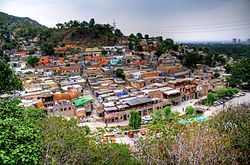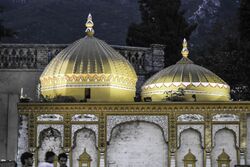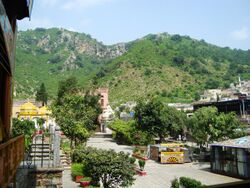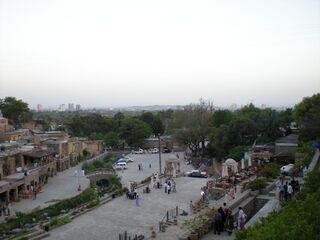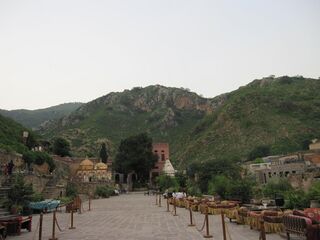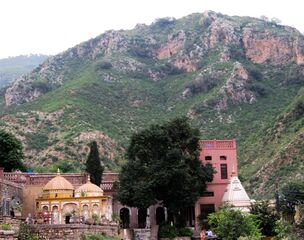Social:Saidpur, Islamabad
| official_name =
| name = Saidpur
سیدپور
| image_skyline =File:Saidpur Village 4.jpg
| imagesize = 240px
| image_alt =
| image_caption = The village is located in the verdant Margalla Hills, just outside Islamabad.
| settlement_type = Village
| coordinates = [ ⚑ ] 33°44′31″N 73°04′04″E / 33.742077°N 73.067708°E
| subdivision_type = Country
| subdivision_name = ![]() Pakistan
| subdivision_type1 = Administrative region
| subdivision_name1 = Template:Country data Islamabad Islamabad Capital Territory
| population_total =
| population_as_of =
| population_est =
| pop_est_as_of =
| population_footnotes =
| area_total_km2 =
| elevation_m = 620
| elevation_m_min =
| elevation_m_max =
| population_density_km2 =
| leader_title =
| leader_name =
| leader_title1 =
| leader_name1 =
| area_code =
| area_code_type = Calling code
| timezone1 = PST
| utc_offset1 = +5
| website =
| footnotes =
Pakistan
| subdivision_type1 = Administrative region
| subdivision_name1 = Template:Country data Islamabad Islamabad Capital Territory
| population_total =
| population_as_of =
| population_est =
| pop_est_as_of =
| population_footnotes =
| area_total_km2 =
| elevation_m = 620
| elevation_m_min =
| elevation_m_max =
| population_density_km2 =
| leader_title =
| leader_name =
| leader_title1 =
| leader_name1 =
| area_code =
| area_code_type = Calling code
| timezone1 = PST
| utc_offset1 = +5
| website =
| footnotes =
}} Saidpur (Punjabi and Urdu: سیدپور) is a historic Pakistani village located in a ravine in the Margalla Hills, near Islamabad and the Daman-e-Koh overlook. The village's historic core, its abandoned Hindu temple, and its Sikh gurdwara were restored in 2006. The village now houses several high-end restaurants, and attracts Islamabad residents and tourists alike.
Etymology
Saidpur is named after Sultan Said Khan, son of Sultan Sarang Khan, the Gakhar chief of the Pothohar region during the reign of the Mughal Emperor Babur.
History
Said Khan gifted Saidpur village to his daughter who was married to Mughal emperor Jahangir son of Mughal emperor Akbar. Jahangir's memoir, Tuzk-e-Jahangiri mentions him residing at a place “beyond Rawalpindi”, on his way to Kabul, which is believed to be Saidpur.
Saidpur was considered a garden resort and a perpetual spring provided water for drinking and for watering gardens around during the Mughal period.
The village was converted into a place of Hindu worship by a Hindu commander, Raja Man Singh. He constructed a number of small ponds: Rama kunda, Sita kunda, Lakshaman kunda, and Hanuman kunda. The region is home to many Hindu temples that have been preserved; showing the history of Hindu civilisation and architecture in the region.
Restoration
In 2006, the Capital Development Authority, under the guidance of Kamran Lashari, initiated restoration of Saidpur, with the aim of both preserving heritage and encouraging tourism. Representatives of the French government provided technical assistance, while French architect Max Boisrobert visited the site on the invitation of Ambassador of France to Pakistan, H.E. Mr. Régis de Belenet.
The initial cost of the project was estimated to be around 400 million rupees.[1]
Economy
Tourism
In 2008, the Capital Development Authority completed the remodelling of Saidpur into a tourist attraction by giving it the look and feel of a quaint village. The key changes that have come about include the re-doing of a temple, the cleaning up of a stream running through the village and giving the mud houses a facelift. The village reflects the traditional ambience; the temple, the stones used on the walls, the stacks of hay, the horse-drawn carts and everything else depicts the history of Pothohar region.[2]
- Preserved old school building
- Restaurants and cafes, including the famous Andaaz Restaurant.
- Nomad Art Gallery
- Preserved old Sufi tomb
- Preserved Hindu temple and Gurdwara
See also
- Saidpur Hatchery
- List of Hindu temples in Pakistan
- Developments in Islamabad
Picture gallery
References
External links
Template:Neighbourhoods of Islamabad
 |
